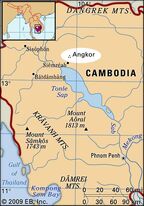
Primary SourceThis is a picture of the Mekong river. It is a primary source because it was taken by someone actually there. This is the river were many invaders attempted to infiltrate the Angkor defenses.

Secondary SourceA map showing where the Angkor empire was in Cambodia. This is a secondary source because it is not official and it is unknown who created it.
1) The adoption of Indian doctrines of deva-raja or "god-king"
The ancient Angkor empire kings adopted a successful monarchy system of Indian civilization as the replica. Being referred to as the "god-king" or deva-raja, the Khmer kings were able to rule over the empire with divine kingship and absolute power. This enhanced the kings to mobilize large manpower to serve in its military force to defend the nation as well as to invade the neighbors. In addition, the kings could maintain their irrigation system which was the prime factor of its successful economy with their Khmer laborers and foreign slaves.
2) Strategic Location
Well-chosen strategic location of the Angkor by its founder Jayavarman II hindered the attack by its potential enemies which enable its existence for over 6 centuries. When the invaders attempted to attack the Angkor empire, they had to sail up from the Mekong River only to meet with the strong defensive force of the Angkor upstream. The enemy's battle ships moved slower making it become an easier target of being attacked and sunk. Throughout the history of over 600 years, Angkor lost only one major naval battle on Tonle Sap Lake to Champa in 1171.
3) Mastery over Water Control
The geographical location of the Angkor Empire faces two seasons, the heavy rainfall during the Monsoon season and the dry period during the off-Monsoon season. Numerous large reservoirs, dikes, moats and ponds helped to prevent floods over the farmland during the heavy rainfall in Monsoon and to conserve water storage for use during the dry season. The efficient irrigation system of the ancient Khmer enabled the empire to cultivate crops two to three times a year which led to high productivity and strong economy of the Angkor Empire.
By Blake Preusker